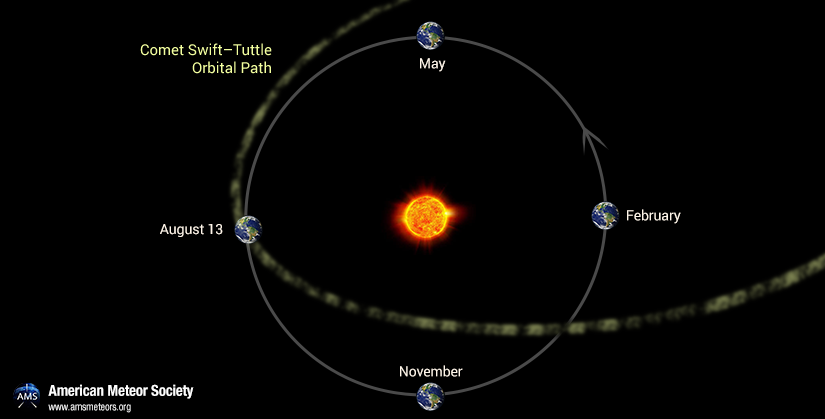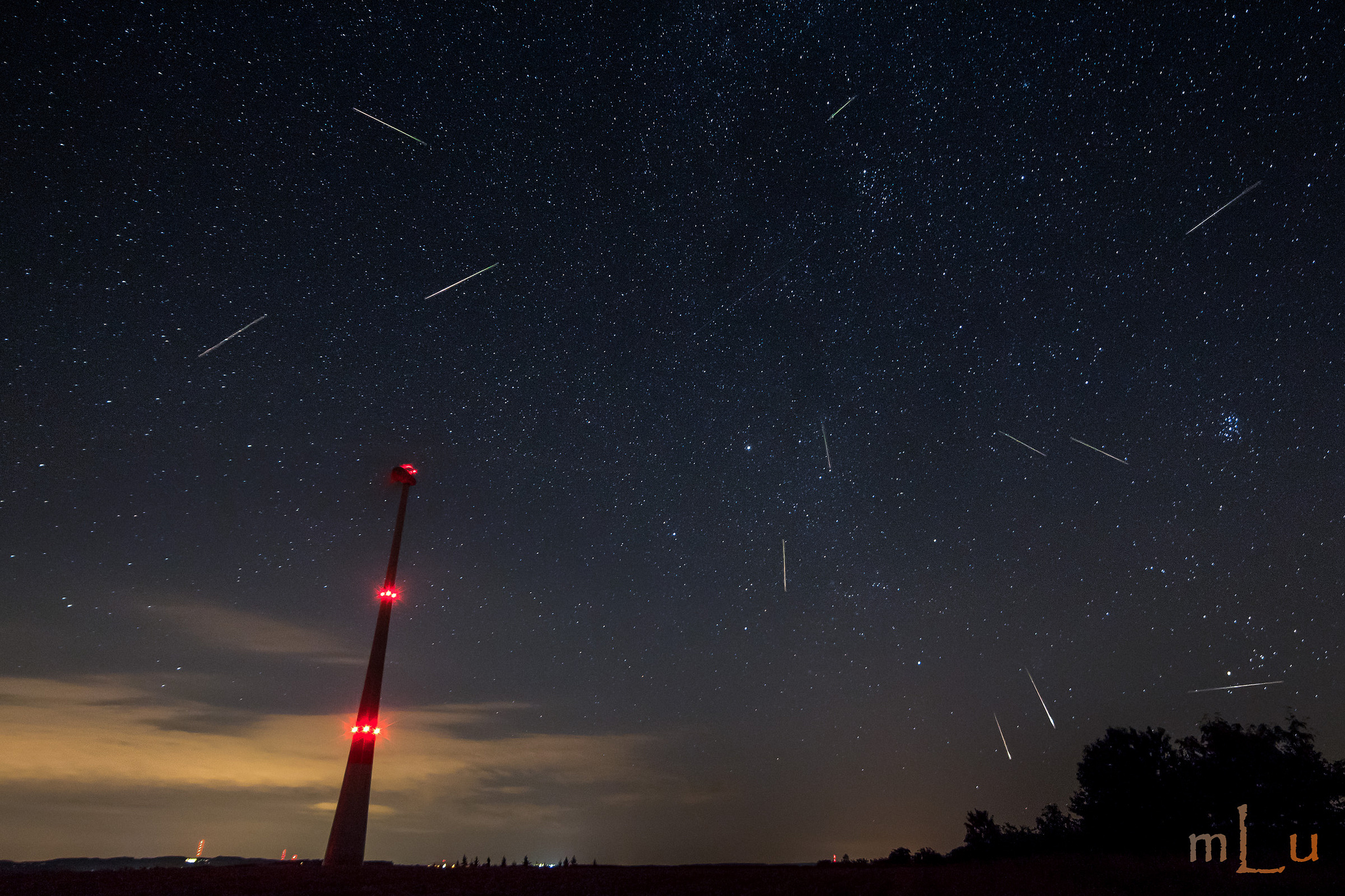
The Perseid is the most gifted Meteor Shower of the year for the Northern Hemisphere. The Perseid offers a consistently high rate of meteors every year and it occurs in August when the temperatures are usually nice enough for a night under the stars!
Comet Dust
Every year, the dust particles from the tail of the Swift-Tuttle comet pass the Earth orbit and burn in our atmosphere (about 70 miles / 110km above us) from mid-July to the end of August. The meteors are in fact glowing columns of air resulting from the burn of these particles. When the dust and ice hits our atmosphere at around 37 miles / second (59km/s) they disintegrate high up in the atmosphere after making a brilliant flash of light. Most of these particles are the size of sand grains, while a few are as big as peas. They can streak across the sky in a flash, or persist for several seconds before vanishing. Meteor Showers peak, or reach maximum, at the same time each year.

Radiant
Meteor Showers are named for the constellation out of which they seem to come. Because all of the particles are moving in roughly the same direction, the meteors which strike our atmosphere all “point” back to the direction of the comet’s path. This point in the sky is called the Meteor Shower Radiant. The Perseids appear to come from a point next to the constellation of Perseus. Perseids can be seen anywhere in the sky, but the direction of motion, when traced back, will point to a point next to the Perseus constellation.

The radiant point for the Perseid meteor shower is in the constellation Perseus (North East, after midnight). But you don’t have to find a shower’s radiant point to see meteors. Instead, the meteors will be flying in all parts of the sky!
2016 Activity
The Perseids are active from July 13th through August 26th. Maximum activity is predicted to occur on the morning of August 12th, when rates in excess of 1 per minute may be seen from dark sky sites. On the morning of maximum the waxing gibbous moon will set between midnight and 0100 local daylight time as seen from mid-northern latitudes. This will free up the prime observing hours from interfering moonlight.
As the sun sets in mid-August, the Perseid radiant lies near the northern horizon for viewers located in mid-northern latitudes. This is certainly not the prime time to view Perseid activity and the moon will further complicate matters. Some Perseid earthgrazers may be visible at this time but the bright moon will obscure all but the brightest meteors. For an hour or so beginning at dusk, you have the opportunity to see Perseid meteors that just skim the upper atmosphere. These are much different than Perseid meteors you see later in the night. With less resistance from air molecules these meteors last much longer and create long trails across the sky, often nearly stretching from horizon to horizon. With the low radiant altitude there will not be many of these meteors to see. Any that you do manage to witness will be memorable. Sky & Telescope magazine had a nice article on these meteors in their August 2014 issue.
As the night progresses the Perseid activity will slowly rise as the radiant gains altitude in the northeastern sky. Not until after midnight will the Perseid radiant gain sufficient altitude to produce pleasing results. Anytime from moonset to dawn will be the best time to see the most activity. Perseid meteors will appear in every portion of the sky. I would suggest facing toward the direction with the flattest horizon, devoid of any trees or hills that may block you view of the meteors. If all directions are favorable, then face toward the darkest portion of the sky, opposite any terrestrial lights that may interfere with viewing. Most people think that facing straight up is the best way to spot meteors. True, by facing the zenith you eliminate any terrestrial interference such as trees or hills. Unfortunately the column of air directly above you is the thinnest slice of atmosphere, therefore producing the least number of meteors. You are better off centering your field of view at approximately one-half the way up in the sky, high enough to avoid anything that may block your view.
The best Perseid rates will occur on a 5 night segment centered on August 12th. So if August 12th is cloudy you can still see good Perseid activity over the weekend. Just be sure to wait until the moon is low or has set before attempting to observe. You should try getting out on the 10th and 11th too as increasing rates will also be entertaining. Besides, the moon will set earlier on these nights allowing more time to watch under dark skies.
The best night for viewing the Perseids will the morning of August 12th. This year predictions by Mikhail Maslov and Esko Lyytinen predict that we will cross a part of the stream which has shifted closer to the Earth’s orbit by Jupiter[1]. Therefore rates could be up to twice as high compared to a normal Perseid display. Normal rates for this shower are usually around 60 meteors per hour as seen from rural observing sites. Therefore this year rates could exceed 100 per hour. Note that meteor activity is notoriously bunched, meaning that there are periods in which you will see no activity and other times when you will see several within seconds of each other. The quoted rates are an average over an hour’s time.
Photograph meteors
The Perseids also offer a good opportunity to photograph meteors. To accomplish this you need a camera capable of taking exposures of at least 60 seconds. It also advantageous to have a wide field lens such as a 24mm or 28mm. These lenses are normally “slow” with a focal ratio of 3.5 or higher. These lenses are still capable of capturing meteors but the lower the focal ration the better as “faster” lenses are more capable of capturing these fast streaks of light. If you simply aim your camera at the sky your time exposure will show the stars trailing through the frame. Meteors will appear as straight streaks of light crossing these star trails. Advanced astrophotographers use motorized mounts for their cameras to follow the stars and to avoid star trails. Meteor streaks will appear as they do in the sky, as streaks of light against a starry background.
2017 may also be a strong year for the Perseids but the waning gibbous moon will severely hinder observers by obscuring all but the brightest meteors. Another moon-free Perseid display will not occur until August 2018. Therefore it is highly recommended that you take advantage of the favorable circumstances occurring this year and get out and view this spectacle. We would appreciate hearing your results and impressions of this display!
[1] Rendtel, Juergen (2015) IMO 2016 Meteor Shower Calendar, Page 12
 American Meteor Society
American Meteor Society
UR info about the Perseids this year is by far the best of all the other reports !!
Thanks Henry, we appreciate your kind comments. It makes the work we do a little more enjoyable knowing that folks like you appreciate our efforts to educate the general public.
Clear Skies!
Robert Lunsford
Yeppa, we appreciate your clear and informative commentary! ! ! Most Helpful!!!
Thanks so much! – -. John G
Thanks so much, I heading out now! Will observe above Lake Oroville, few lights, should be fantastic! Great tips! Happy trails, Lauralyn
Very good info on the Perseid this year. Now I just have to figure out where to go to avoid clouds (I live in Columbus, OH). I might try flying someplace but last minute flights are expensive. Based on this map, it looks like i need to fly somewhere out west:
http://www.accuweather.com/en/features/trend/perseid_meteor_shower_viewing_conditions_forecast_2016_where_when_to_view/59311665
Thanks for the great info, insight and advice.
Will be viewing this the next few nights.
Again, many thanks
Bill
It appears that St. Louis, MO will be cloud covered the morning hours the Perseids are at their peak. Where is the place most near St. Louis (any direction) where clear skies can be found? Thank you very much for your reply.
Chuck,
I would check out the satellite picture at: http://www.goes.noaa.gov/browse2.html
I hope this helps!
Robert Lunsford
American Meteor Society
for Robert Lunsford…I saw something in the night sky of August 12th that I have never seen in my years of enjoying the Perseids…looked like a small black ball on fire cruising across the sky, and even though I know it was quite high, appeared unusually low. I suspect meteor/meteorite entering the atmosphere and literally on fire…but could you explain it more definitively for me? Pretty amazing, and something I will not soon (or ever!) forget!
Sherry and All,
We often receive reports of fireballs that appear to have a dark center. These objects can also appear to be on fire but it is actually an interaction between the object and the atmosphere. Your object sounds as if it was moving slower than a usual meteor. Therefore you witnessed the object itself disintegrating with traveling through the atmosphere. The fire-like light was the heating of the object to a point where ablation caused it to break up. If a meteor has sufficient velocity, it can also cause the column of air that it passes through to temporarily glow. You typical bright Perseid meteor is a good example of this.
I hope this helps!
Robert Lunsford
Thank you so much for this detailed information Bob! Yes, I too am trying to figure where to go tonight to escape Boston light pollution. Last year I just drove and drove and ended up somewhere in NH in a ballfield. I don’t even know which town. This website might show probable cloud cover for the country:
http://www.accuweather.com/en/us/boston-ma/02108/astronomy-daily-forecast/348735?day=1
Here’s to seeing a great show tonight!
This is the best information I’ve found. Thank you!
Thank you very much for the information while I live in the city of Philadelphia it is hard to find a unlit area. I was able to witness about 3 meteors. I also saw some interesting flashes of light that lit up the entire Sky I am not sure where they came from but they had the effect of lighting. At first I thought it was lights in my neighborhood but the second time it was clearly in the sky as it actually lit up the clouds. Any idea what this was?
I live in NJ between Philadelphia and Trenton. This morning between 3 and 3:30 I witnessed what appeared to be a meteor. It had a noticeable head that streaked from north to south. It was about midway between the horizon and the zenith in the western part of the sky. It’s magnitude rivaled Venus at maximum magnitude which is what caught my attention. Never saw that bright an object travel that fast across the sky.